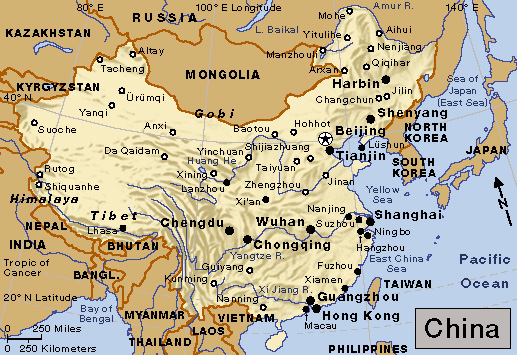Xinjiang, << shihn jee ahng >>, also spelled Sinkiang, is a region in western China. Ürümqi is Xinjiang’s capital and largest city. Other major cities include Aksu, Changji, Hami, Karamay, Korla, and Shihezi.

Much of Xinjiang is a desolate, thinly populated land of deserts and mountains. The region covers about 17 percent of China’s land but has only about 1.5 percent of its population. Xinjiang is one of five autonomous (self-governing) regions in China. The Chinese government created the autonomous regions for China’s largest minority groups. The autonomous regions operate under the Chinese government, but they also have additional powers to pass laws related to ethnic group affairs.
Xinjiang has about 24 million people and more than 40 ethnic groups. Uyghurs (also spelled Uighurs), a Muslim Turkic-speaking people, make up more than 45 percent of Xinjiang’s population. Han Chinese constitute about 40 percent of the population. Other groups include people of Kazakh, Kyrgyz, Mongol, and Uzbek origin, as well as Hui (Chinese Muslims). Xinjiang’s chief religion is Islam.
Farming and herding are important economic activities in Xinjiang. Farmers grow corn, sugar beets, and wheat. The region is also well known for its cotton, Turpan grapes, and Hami melons. Herders raise cattle, sheep, and other animals. Natural gas, oil, and petroleum are Xinjiang’s largest industries. Other industries include food, metals, and textiles. Xinjiang’s vast mineral resources include coal, gold, iron ore, lead, and zinc.
Xinjiang was on the Silk Road, an old trade route that connected the Middle East and Europe with China. China first ruled Xinjiang during the Han dynasty (206 B.C.-A.D. 220) and later during the Tang dynasty (618-907). After periods of Uyghur and Mongol control, the Chinese controlled Xinjiang again during the Qing dynasty (1644-1912) and made it a province in 1884. In 1955, it became the Xinjiang Uyghur Autonomous Region.
With government encouragement, many Han Chinese from other parts of China have moved to Xinjiang, especially since the 1990’s. In the early 2000’s, ethnic unrest and Uyghur separatist movements developed. Chinese authorities responded with thousands of arrests. In 2017, they imposed strict surveillance on the Uyghurs. Human rights organizations estimate that China has sent about a million Uyghurs to camps for what Chinese officials call vocational training to combat terrorism. In 2018, a United Nations report called on China to end the detentions, but Chinese policy remained unchanged.
See also Turkestan.
